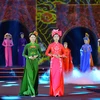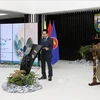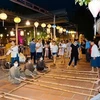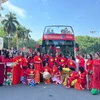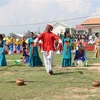 Artists perform Hue folk singing on a tourist boat on Hương River in Hue City (Photo Vietnam Pictorial)
Artists perform Hue folk singing on a tourist boat on Hương River in Hue City (Photo Vietnam Pictorial) Hanoi (VNA) - The Thua Thien – Hue Culture, and Sports Department is compiling a scientific dossier for Huế folk singing to seek UNESCO’s recognition as an intangible heritage.
Accordingly, the Department is completing an inventory report on Hue singing heritage, collecting documents in printed and written forms and items relating to Hue singing at home and abroad and filming performances of Hue singing to made audiovisual products.
It is also organizing training courses to improve the professional qualifications and quality of Hue singing for actors and musicians in the province; formulating a program to preserve and promote the value of the heritage; strengthening management and reorganizing Hue singing activities on Huong river, developing Hue auditorium singing.
Thua Thien-Hue Province has implemented a program to bring Ca Hue to a school to arouse the passion and raise the awareness and responsibility of the younger generation in preserving and promoting this heritage value.
The Department of Culture and Sports of Thua Thien-Hue Province cooperates with the Department of Education and Training of the province in developing and implementing a program to bring Ca Hue heritage into schools with two contents such as training of Hue singing for sound teachers. music of secondary schools in Hue city and Ca Hue singing for students in the form of Ca Hue Club at the secondary schools.
Ca Hue Club model has been implemented in many schools in Hue city. The schools have actively developed organizational plans, with various forms such as organizing performances of Ca Hue singing in the flag-raising ceremony at the beginning of the week, the opening ceremony and anniversaries, the cultural and extracurricular festival program. learn about Hue songs in order to spread and create positive effects on Ca Hue art heritage.
As a result, the model of Hue singing Club at secondary schools in the city has attracted the attention of many students, for example Tran Cao Van Secondary school has 31 students, Nguyen Tri Phuong Secondary School has 25 students.
From the beginning of the 2019-2020 school year, Thong Nhat Secondary School established the Hue singing Club with the participation of nearly 100 students.
They are directly taught by teachers of Thua Thien-Hue Culture and Arts Intermediate School, so they have mastered the standards in each song and dance.
The Culture and Sports Department, the Education and Training Department organize a Ca Hue training course for music teachers of junior high schools in Hue city.
Hue singing was born around the seventeenth century, becoming an elegant hobby of the royal families during the long time when Hue was the capital of Dang Trong, then the capital of the whole country under the Nguyen Dynasty. It reached the peak from the Minh Mang reign (1820-1840) to the Tu Duc reign (1848-1883).
Hue singing is born from the court, then spread to the folk, blending with the thriving folk music of Hue, creating a clear local identity with two main rhythms.
The art includes singing, instruments of traditional melodies ranging from royal performance to daily life.
There are 60 folk melodies for singing and instruments in northern and southern styles.
Huế folk songs have strict structures, which have developed into professional classic styles in lyrics, melodies and performances.
Various traditional instruments accompany the singer including the 16-string zither, two-string zither, monochord, flute and drum.
Delicate skills in singing and playing instruments in the art of Huế folk singing bear significant local features with the accent of Huế people. The art has been considered a bridge between royal and folk music genres.
The UNESCO recognition is part of efforts by the government to preserve cultural values and national heritages.
Hue was the seat of the Nguyen Dynasty, the last royal family which ruled the country from 1802 to 1945. It is home to royal tombs, ancient palaces and pagodas that attract millions of foreign visitors every year./.

